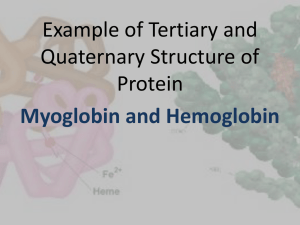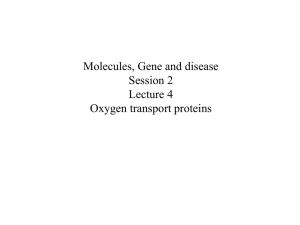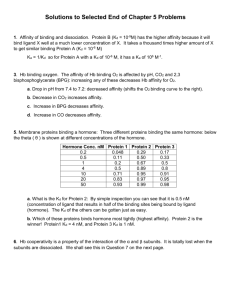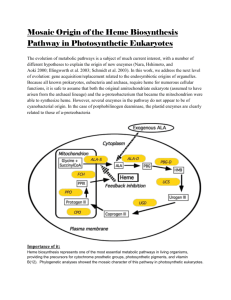2 models for cooperative interaction
advertisement
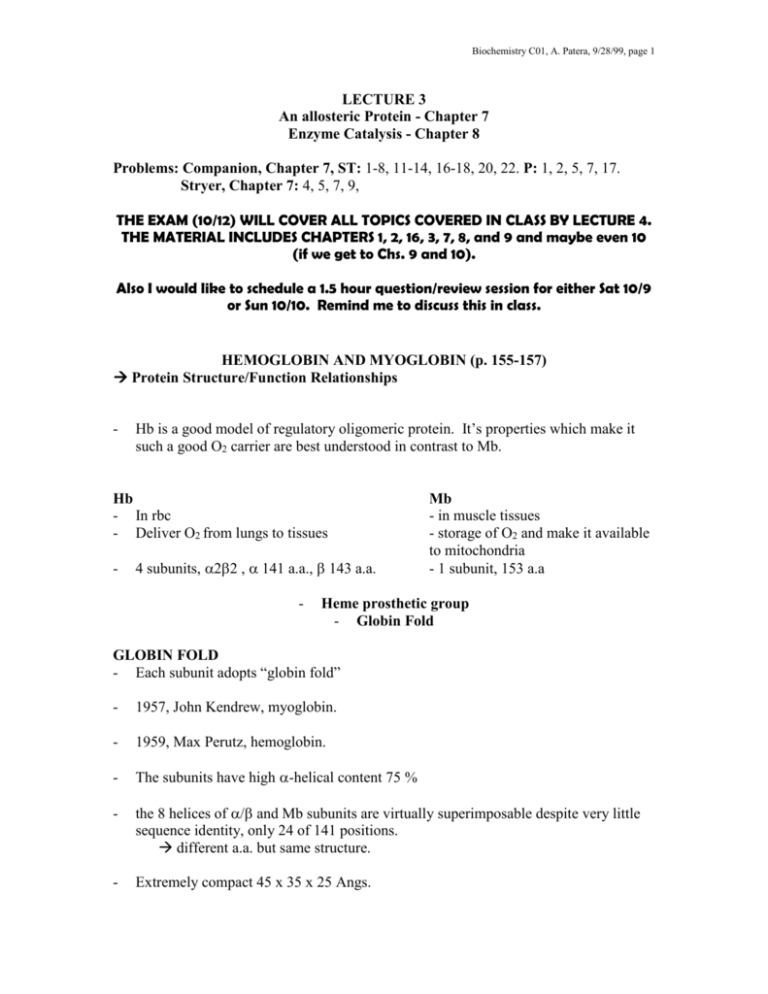
Biochemistry C01, A. Patera, 9/28/99, page 1 LECTURE 3 An allosteric Protein - Chapter 7 Enzyme Catalysis - Chapter 8 Problems: Companion, Chapter 7, ST: 1-8, 11-14, 16-18, 20, 22. P: 1, 2, 5, 7, 17. Stryer, Chapter 7: 4, 5, 7, 9, THE EXAM (10/12) WILL COVER ALL TOPICS COVERED IN CLASS BY LECTURE 4. THE MATERIAL INCLUDES CHAPTERS 1, 2, 16, 3, 7, 8, and 9 and maybe even 10 (if we get to Chs. 9 and 10). Also I would like to schedule a 1.5 hour question/review session for either Sat 10/9 or Sun 10/10. Remind me to discuss this in class. HEMOGLOBIN AND MYOGLOBIN (p. 155-157) Protein Structure/Function Relationships - Hb is a good model of regulatory oligomeric protein. It’s properties which make it such a good O2 carrier are best understood in contrast to Mb. Hb - In rbc - Deliver O2 from lungs to tissues - 4 subunits, 22 , 141 a.a., 143 a.a. - Mb - in muscle tissues - storage of O2 and make it available to mitochondria - 1 subunit, 153 a.a Heme prosthetic group - Globin Fold GLOBIN FOLD - Each subunit adopts “globin fold” - 1957, John Kendrew, myoglobin. - 1959, Max Perutz, hemoglobin. - The subunits have high -helical content 75 % - the 8 helices of / and Mb subunits are virtually superimposable despite very little sequence identity, only 24 of 141 positions. different a.a. but same structure. - Extremely compact 45 x 35 x 25 Angs. Biochemistry C01, A. Patera, 9/28/99, page 2 - Non polar inside, charged residues outside. - , have non-helical 5 residues @ C-terminus. - In globins, 9 highly conserved residues. Involved in heme binding or interaction between helices. (Table 7-2) - Different Hb’s from diff’t species, have considerable variability in the interior makeup. Where there is a.a replacements, the changes are conservative. Non-polar to nonpolar. No difference in overall shape and function of protein. - (**Sickle cell anemia exception**) - Exterior of protein varies greatly. Still, globin fold is maintained. This speaks to the independence of 1 structure and 3/4 structure. HEME IN Mb/Hb (p 148) Free Heme - It’s a prosthetic group (like a cofactor but covalently bound, a permanent part of protein). - Protein w/o prosthetic group : apoprotein - Organic part is protoporphyrin ring IX : 4 pyrrole rings w/ Me bridges - Flat molecule - Fe atom bound to 4 N’s in center of protoporphyrin (p 148, Fig 7.3) - Fe can form 2 additional bonds (termed 5th and 6th coordinate) - Fe can be in ferrous +2, or ferric +3 - Heme gives rbc their color, muscle their color [packaged meat, keep Fe red] Mb (or Hb) bound heme (p. 150) - Located in crevice - Polar groups on heme are on surf. of protein. Biochemistry C01, A. Patera, 9/28/99, page 3 - @ pH 7 – groups are ionized rest of heme’s buried in non-polar group. - Except 2 histidines F8 and E7. - F8 is bound to Fe (5th coordinate pos’n) - Fe is out of plane by 0.4 angs - The O2 bind site is on other side of heme. - The 2nd his E7 (termed distal his) is near but not bonded.( E- density for heme fig 7-9) - The 3 conformations of deoxy, oxy, ferriMb are very similar but for 6th coordinate postion : Deoxy 6th coord position is empty Oxy -“occupied by O2 Ferri -“-“by H2O - When O2 bound, axis of O2 @ angle wrt to Fe-O bond.( See drawing). and Fe moves into the plane of the heme flat If free heme can bind O2 , why do you need the rest of the polypeptide? (p. 150-153) - In water, free heme binds O2 transiently Fe(+2) + O2 Fe(+3) - Fe (+3) cannot bind O2. - A necessary intermediate in this rxn is [heme]- O2 -[heme] sandwich - In Mb two hemes (in 2 Mb) can’t associate [ox] doesn’t easily happen. Evidence – “Picket fence heme” - Picket fence heme made to mimic Mb/Hb O2 binding site. - One side left unhindered to bind imidazole (his), other side has protective enclosure of O2. - When imidazole binds, picket fence porphyrin heme complex, has same affinity for O2 as Mb. Biochemistry C01, A. Patera, 9/28/99, page 4 - The picket fence structure appears to stabilize Fe (+2) form making it possible to bind (reversibly) O2 for long time. Difference between free heme and this structure is picket fence steric hindrance is part of the role of the polypeptide. HEME BINDING CO (p.152) - CO is poison cause it bind ferro Mb/Hb. - In soln, CO bind 25,000 better to free heme than O2. - BUT in the protein the affinity fo CO is only 200 X as great as O2. Why the drop in CO affinity for free heme vs. globin bound heme? - Free heme binds CO linerarly - O2 binds heme angled. - In Hb/Mb CO is forced, due to steric hindrance by distal his, to be angled like the O2. This prevents good tight binding to heme Fe. the protein reduces the binding affinity of CO by forcing it into bent geometry. The protein has created a microenvironment which modulates the chemistry/function of the prosthetic group. HEMOGLOBIN (p. 154) - Hb A is made of 4 globin subunits 22 - (Max Perutz) Subunits packed tetrahedrally - subunits are interacting non-covalently contacts 2 's, little contact between 's and 's. - Each subunit has a heme and a O2 binding site. - Heme is near exterior of molecule - The 4 O2 bind sites are far apart. - Other Hbs: A2 22, embryonic/fetal Hb fetal Hb infant Hb 22 . ( 141 a.a; and 146 a.a.) Biochemistry C01, A. Patera, 9/28/99, page 5 How is Hb different than Mb? How do their roles differ? O2 BINDS Hb COOPERATIVERLY (p. 157-159) Hill Plot (p. 159) - Components of Hb and Mb are remarkably similar, but physiological roles are very different. - @ high [O2] (pO2) both molecules bind the same amount of O2 per protein weight. @ low p O2 the affinity is difft. (see O2 binding curves, p157, Fig 7-20) at low pO2 Hb has lower affinity for O2. @ low pO2 Hb gives up its oxygen more readily than Mb. Mb has higher affinity for O2 than Hb. Note that Mb plot is hyperbolic, Hb is sigmoidal. Biochemistry C01, A. Patera, 9/28/99, page 6 Archibald Hill before the structure of Hb 1913 proposed following model for O2 binding to Hb, which matched experimental data. n = average # binding sites. Plot on Hill plot, "guess-timating" the value of n to get a linear plot. Slope @ Y = 0.5 , n = Hill coefficient. n = whole integer independent binding, good correlation with # binding sites. n>1 cooperativity, poor correlation with # binding sites. Do a similar analysis for Mb, where the # of binding sites is 1. - For Mb n = 1 matches crystal data of 1 binding site for O2. Hb n = 2.8 but 4 binding sites, not 2.8. Usefulness of Hill coefficient ? - It implies that O2 are not binding independently, rather cooperatively. That the binding of 1 ligand greatly enhances further binding of another, etc… Hb can deliver more O2 if the binding is not independent. (p159) ( Sigmoid binding curves are characteristic of positive cooperativity) Multiple subunits of Hb and the interaction between these results in a fundamental difference between O2–binding of Mb and Hb. (You want Hb to have poor affinity in active muscle so that O2 can be delivered by Hb) The cooperative binding of O2 by Hb is well suited to its role as transporter. In lung where p O2 = 100 mmHg Hb is nearly saturated , whereas in tissue where p O2 = 20 mmHg Hb can release ~ ½ its oxygen. Biochemistry C01, A. Patera, 9/28/99, page 7 Hb : ALLOSTERIC PROTEIN (p. 159-160, 164) The binding of small ligands to the Hb influence O2 affinity. Each of these ligands, binds at different, non-overlapping sites. The binding must be transmitted through the protein chain this regulation is allostery. Ligands affecting affinity of Hb for O2. 1. Lowering pH (increased H+) decreases O2 affinity. More O2 is released. In tissues: Increasing [CO2] HCO3- + H+ less O2 binding. In Lungs: Increase [O2] release of H+ H+ + HCO3- H2O + CO2 CO2 exhaled. Bohr effect: mechanism for meeting the increased demand for O2 by metabolically active tissues. The relationship between binding of O2, H+ and CO2. 2. 2,3- bisphophoglycerate (BPG) - BPG lowers affinity for oxygen by factor of 26 - W/o BPG Hb behaves like Mb with P50 of 1mmHg 3. Covalent attachement of CO2 - CO2 is mostly transported as bicarbonate (carbonic anhydrase) The H+ is taken up as the Bohr effect. But the rest of the CO2 can covalently bind to -amino groups of Hb, as carbamate. - Carbamate form salt bridges and stabilize T form of protein. FETAL Hb - Fetal Hb 22 has higher oxygen affinity than mHb. When the mHb gives up oxygen, the fHb is ready to pick it up. - It’s not as affected by BPG 22 has residues mutated a BPG binding pocket which make it difficult for BPG to bind. (ser for a his) Biochemistry C01, A. Patera, 9/28/99, page 8 Hb STRUCTURAL CHANGES WITH OXYGENATION What are the structural basis for allosteric effects by H+, BPG and CO2 on Hb? - On their own the subunits and have no allosteric properties. The tetramer does. - The structure of deoxy and oxy are difft. T and R forms. (For allosteric proteins by definition the T form has decreased activity towards substrate wrt R form) - 1 1 dimer moves wrt 22 dimer in the oxy form by 15 . - The interface between the movable dimers contains a network of salt bridges and Hbonds when in deoxy form. In oxy form, very few interactions. The 4 transformation which takes place upon binding of oxygen, requires that the network of interactions be broken. H+ and BPG – structurally - The effects of H+ and BPG can be understood in terms of stabilizing the deoxy conformation. - Hb binds H+, which helps buffer pH for active tissues. - Oxygen binding decreases as pH decreases form 7.6 to 6.8. This data implies the side chain of an amino acid whose pKa is in the vicinity of this pH. Histidine is the only a.a. with a side chain near this range. As the pH drops the R group must be able to be protonated (to pick up H+), the pKa of the his will go up. Actually 2 a.a residues which are involved. Asp 94 and His 146. The proximity of asp to the his, helps with the protonation of his. Asp raises the pKa of His. the charged his can now be involved in inonic interactions stabilizing the deoxyform. This lessens the likelyhood of forming oxy form. Drop in O2 binding affinity. - BPG binds strongly the deoxyform because of ability to fit into central cavity and charge complementarity. (in fHb, H143S) Biochemistry C01, A. Patera, 9/28/99, page 9 O2 BINDING AT THE HEME The conformational changes (changing of H-bonds and salt bridges) are occuring far from the center of activity, the O2 pocket. It’s the binding of oxygen at the heme which forces the 3 and 4 changes that are responsible for cooperative effects in Hb. (See p 163) Fe (2+) w/o oxygen is out of plane When oxygen binds, the Fe(2+) orbitals rearrange and contract, the Fe(2+) sits into the heme. As a result it pulls the histidine of the F helix. This forces a change @ the subunit interface. A small change is transmitted through the peptide to distal part of the molecule 2 MODELS FOR COOPERATIVE INTERACTION 1. - Sequential: 3 assumptions are made: There are 2 states, either T or R, both can exist in the same tetramer. Ligand affects only one subunit Conformational change increases affinity of next molecule. 2. - concerted there are 2 states, R or t, but the protein is either all T or all R. ligands bind w/ low affinity to T and high affinity to R. binding of ligand increases probability that all subunits are in R form. The real mechanism is more complicated and is a combination of both models. SICKLE CELL ANEMIA Abnormal Hb. One reside mutation, glu6val. val is exposed The mutation introduces a “sticky” patch on the outside of the protein. Increases the likelyhood of aggregation. Aggregation causes fiber formation. This deforms the rbc. (The aggregation affects deoxygenated form of the Hb.) Shortens lifetime of rbc defense agains malaria. THALASSEMIAS Defective synthesis of Hb chains unstable Hb chains, rapid degradation defense against malaria. Biochemistry C01, A. Patera, 9/28/99, page 10 ENZYME CATALYSIS CHAPTER 8 What are enzymes? What are some characteristics? Catalysts Increase rate of rxn Specificity Bind specifically to substrate, turn it into product and then return to original form Means of regulation of rxn Spatial geometry descriminates between substrate and other molecules Active site, small part, cavity or pocket of enzyme Functional groups that catalyze the reaction are in active site Activation of substrate Affects reaction rate, NOT equilibria Decrease of activation energy, or Gts, free energy of transition state May use cofactors or prosthetic groups How an enzyme works The biochemical reactions that enzymes catalyze are unfavorable. An enzyme circumvents these problems by providing a specific environment within which a given reaction is energetically more favorable. It can do this in the active site where it brings into close proximity the reactant(s) to transform them into product. Enzyme-Substrate complex The general reactions that enzymes catalyze 1) Group transfer 2) Oxidation reduction 3) Rearrangement 4) Cleavage 5) Condensation Enzymes are classified by the reactions that they catalyze ENZYMES AFFECT RXN RATES NOT EQUILIBRIA Distinguish: reaction equilibrium and reaction rate Energetic course of the reaction is plotted A favorable equilibrium doesn’t mean that going from SP is fast. The rate of the reaction is dependent on the size of the energy barrier required to undergo the transformation of SP. At the top of the hill is the TS (not intermediate) An enzyme that catalyzes SP also catalyses PS Biochemistry C01, A. Patera, 9/28/99, page 11 In the presence of enzyme the reaction reaches equilibrium faster. Glucose + O2 CO2 + H2O very –ive dG but glucose is stable….activation energy is huge. Enzymes make reactions happen on useful time scale for cells. A reaction with several steps has reaction intermediates (valley of reaction coord) When several steps occurring a reaction, the overall rate is determined by the highest activation energy. This is the RLS. THERMODYNAMICS – REVIEW
